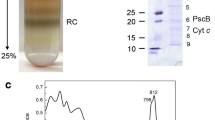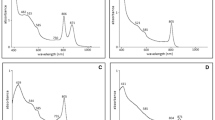Abstract
Membrane preparation from the bacteriochlorophyll-containing cells of a facultative methylotroph, Protaminobacter ruber strain NR-1, contained reaction center bacteriochlorophyll similar to those in many species of purple bacteria and contained a few cytochrome species. α-Peak of the reduced-minus-oxidized difference spectrum of one of the cytochromes was at 554 nm. The midpoint potential of the cytochrome at pH 7 (Em7) was 350 mV. Two other cytochromes had the same reduced-minus-oxidized difference spectra with a split α-band at 557 and 566 nm, but had two different Em7s' of 130 mV and 0 mV.
On flash or continuous light the reaction center bacteriochlorophyll and the cytochrome with α-peak at 554 nm were reversibly oxidized. Redox titration of the light-induced cytochrome oxidation gave an Em7 value of 356 mV. Under continuous illumination the membrane preparation reversibly took up protons, and formed ATP in the presence of ADP and inorganic phosphate. The ATP formation activity on the bacteriochlorophyll basis was one-third to one-fifth that in chromatophores from Rhodospirillum rubrum under similar experimental conditions. These results clearly indicated that the membrane preparation from P. ruber which contained bacteriochlorophyll had a cyclic photosynthetic electron transfer system and coupled ATP formation activity.
Similar content being viewed by others
Abbreviations
- Bchl (only in figure legends):
-
bacteriochlorophyll
- CCCP:
-
carbonylcyanide-m-chlorophenylhydrazone
- Eh :
-
the ambient redox potential
- Em7 :
-
the midpoint potential at pH 7
- PMS:
-
N-methylphenazonium methosulfate
- MES:
-
morpholinoethanesulfonic acid
- MOPS:
-
morpholinopropanesulfonic acid
References
Bowyer JR, Crofts AR (1980) On the mechanism of photosynthetic electron transfer in Rhodopseudomonas capsulata and Rhodopseudomonas sphaeroides. Biochim Biophys Acta 636:218–233
Clayton RK (1963) Absorption spectra of photosynthetic bacteria and their chlorophylls. In: Gest H, San Pietro A, Vernon LP (eds) Bacterial Photosynthesis, Antioch Press, Ohio, pp 495–500
Cusanovich MA, Bartsch RG, Kamen MD (1968) Light-induced electron transport in Chromatium strain D II. Light-induced absorbance changes in Chromatium chromatophores. Biochim Biophys Acta 153:397–417
Dutton PL, Petty KM, Bonner HS, Morse SD (1975) Cytochrome c 2 and reaction center of Rhodopseudomonas sphaeroides Ga. membranes. Extinction coefficients, content, half-reduction potentials, kinetics and electric field alterations.ibid. 387:536–556
Falk JE (1964) Porphyrins and metalloporphyrins, Elsevier, Amsterdam, pp 181–184
Harashima N, Nakagawa M, Murata N (1982) Photochemical activities of bacteriochlorophyll in aerobically grown cells of aerobic heterotrophs, Erythrobacter species (OCh 114) and Erythrobacter longus (OCh 101). Plant Cell Physiol 23:185–193
Kakuno T, Bartch RG, Nishikawa K, Horio T (1971) Redox components associated with chromatophores from Rhodospirillum rubrum. J Biochem 70:79–94
Lowry OH, Rosebrough NJ, Farr AL, Randall RJ (1951) Protein measurement with the Folin-phenol reagent. J Biol Chem 193:263–275
Nishimura M, Ito T, Chance B (1962) Studies on bacterial photophosphorylation III. A sensitive and rapid method of determination of photophosphorylation. Biochim Biophys Acta 59:177–182
Okamura K, Takamiya K, Nishimura M (in press) Photosynthetic and respiratory electron transfer systems in an aerobic photosynthetic bacterium sp. strain OCh 114. In: Proc 6th Int Congr Photosynthesis
Parson WW, Case GD (1970) In Chromatium, a single photochemical reaction center oxidizes both cytochrome c 552 and cytochrome c 555. Biochim Biophys Acta 205:232–245
Prince RC, Dutton PL (1977) Single and multiple turnover reactions in the ubiquinone-cytochrome b-c 2 oxidoreductase of Rhodopseudomonas sphaeroides. The physical chemistry of the major electron donor to cytochrome c 2, and its coupled reactions. ibid. 462:731–747
Sato K (1978) Bacteriochlorophyll formation by facultative methylotrophs, Protaminobacter ruber and Pseudomonas AM 1. FEBS Lett 85:207–210
Sato K, Shimizu S (1979) The conditions for bacteriochlorophyll formation and ultrastructure of a methanol-utilizing bacterium, Protaminobacter ruber, classified as non-photosynthetic bacteria. Agric Biol Chem 43:1669–1975
Takamiya K, Hanada H (1980) Cytochrome b 560 in chromatophores from Chromatium vinosum. Plant Cell Physiol 21:979–988
Takamiya K, Doi M, Okimatsu H (1982) Isolation and purification of a ubiquinone-cytochrome b-c 1 complex from Rhodopseudomonas sphaeroides.ibid. 23:987–997
Author information
Authors and Affiliations
Rights and permissions
About this article
Cite this article
Takamiya, Ki., Okamura, K. Photochemical activities and photosynthetic ATP formation in membrane preparation from a facultative methylotroph, Protaminobacter ruber strain NR-1. Arch. Microbiol. 140, 21–26 (1984). https://doi.org/10.1007/BF00409766
Received:
Accepted:
Issue Date:
DOI: https://doi.org/10.1007/BF00409766




